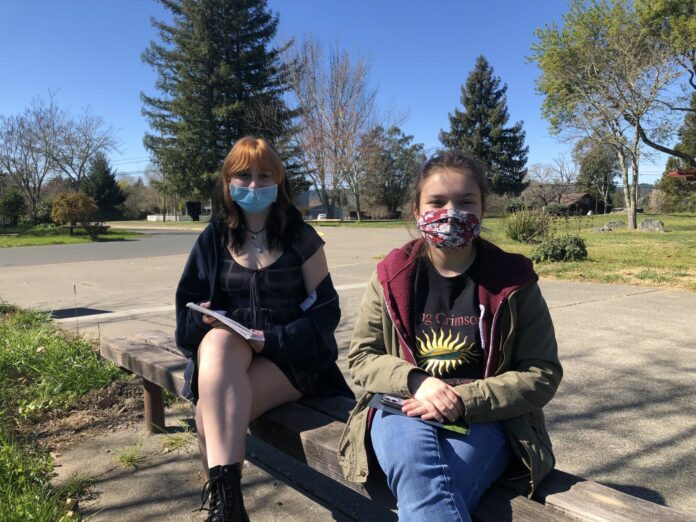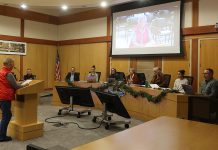
Keep your hand moving and cross nothing out, forget about spelling, punctuation and grammar for now, remember to lose control and do not even try to make sense. According to 16-year-old Julia Wright, these are the fundamentals of creative writing at the heart of Laguna High School’s literary magazine.
Each semester, the magazine arranges poems, free-writes, short stories and a couple essays penned and illustrated by students in Gianna De Persiis Vona’s English and creative writing classes, where she says the best prompt is no prompt.
Wright looked back on how uneasy she first felt without rules to structure her work, not only permitted but directed to write anything she wanted.
“Anything is such a broad thing. It was kind of scary, but I got used to it,” she said. The junior writes in her journal like a diary now, processing what’s personal to her and making up stories about them. Last fall, Wright contributed two pieces to the magazine’s latest edition, “Deadly Season.”
Most teenagers come to West Sonoma County Union High School District’s continuation school in Forestville with a lot of English credits to make up — two if not three classes’ worth usually — so creative writing is offered as an elective and an English course, said De Persiis Vona.
“You don’t want to have them going out of their minds. You know, their least favorite subject and ‘Oh, guess what, you have to take it a few times a day,’” she said. “So, you’ve got to be inventive.”
In De Persiis Vona’s class, students exercise writing without stopping. They may be timed for 10 minutes with prompts pulled from a bag of ideas they came up with, “and you can write about anything you want. It’s not structured writing time,” she said. It’s not something her students get to do much in school, either.
She’s found that many teens have decided writing isn’t for them by the time they reach high school.
“They hate it, they don’t think they can do it, it makes them feel stupid,” said De Persiis Vona, but in creative writing, youth can learn to let go and become flexible in their writing. “I tell them it’s like yoga for the mind,” she said.
De Persiis Vona takes their notebooks home to read through periodically, except the entries marked as private. “And I’ll say, ‘This is good. Can I please have this for lit mag?’ and they’ll say, ‘What, this? This junk? Why?” and so it goes for a whole semester of nagging for students to type up their work, she said.
These pieces are assembled into a chapbook, a pamphlet of stories, poems and more that in practice dates back to the 16th century as a form of street literature. De Persiis Vona said she learned how to craft chapbooks from the author Richard Denner.
“He really taught me that writing for the sake of writing is meaningful and that it doesn’t matter if your work is getting published or getting acclaim, that you can give your work value by creating a book for yourself and that in and of itself becomes the goal. That is the goal for the writing,” she said. Chapbooks are “the artistry of writing,” De Persiis Vona added.
“It’s like framing your work if you were a painter and for the kids, it’s a continuation school, you know,” she said. “Their ideas about themselves, often to do with writing and academics, can be pretty low. Their self-esteem can be pretty low. And this is my way of showing them their work has value.”
Students drum up a list of titles — “and most are awful, sometimes don’t make sense — one is ‘Dude, where’s my pencil?’” — and argue for a while and then vote for their favorite, the teacher said. In spring 2021, the teens went with “Be Like the Plants” and in fall, they chose “Deadly Season.”
“I imagine it probably had something to do with the pandemic,” she chuckled. “Just guessing.”
The class throws a party at the end of the semester and each student receives their copy of the magazine. De Persiis Vona gets between 65 and 100 printed in a run, so copies are available for free any time of the year. The covers come out nice and shiny thanks to an annual donation from the Rotary Club of Sebastopol, she noted.
Creating the literary magazine gives students confidence, a voice and an accomplishment, she said. “They don’t think they care, and then once it comes out, I see them being really proud of it, and it ends up being meaningful to them in a way maybe they didn’t think it was going to be.”
In the beginning, Ciara Garcia didn’t think she’d submit any of her writing to the magazine. “This hasn’t been something that had ever been offered to me in any English class I’ve ever been in, so it was kind of a whole new experience for me to learn about,” she said.
The 16-year-old’s got a penchant for writing, though, and seeing her work take wing in the final print filled her with pride.
“And it kind of struck a chord with me because I’m really a big fan of poetry,” she said. “I love writing it, I love reading it, and I think poetry helps people express themselves, so I wrote a poem for the literary magazine.”
Garcia said she also likes swapping in unexpected words in her sentences to change their meaning and she finds that most of her poems lean either melodic or melancholic. “And I like to get in touch more with my melancholic side because I find I write a lot better when I have these weird feelings inside me,” she added. “So, it’s kind of a good chance to get my feelings out and it kind of just becomes a poem, I guess.”
Garcia said she might try to snag a seat in another poetry or creative writing class her senior year, when Laguna offers 12th graders the opportunity to take college-level courses. In the long term, she considers minoring in the subject.
“I really like writing, and I feel like I’m pretty creative, but I feel like I’ve had a bit of a hard time actually enjoying my English classes,” Wright said, reflecting on tough teachers and uninspiring assignments. Later, she said, “it’s just really amazing what we’re doing here and stuff, and I’ve never actually enjoyed writing or reading this much.”
Wright had the two pieces she wrote published anonymously in last semester’s magazine, which she voiced a little regret for despite how personal some of her writing was.
De Persiis Vona said the magazine’s content can become sensitive, but she does find that her students often regret choosing anonymity. “But I’d rather that than if they put their name on it and wish they hadn’t,” she said, lest family members find out what they wrote. “I really have to be protective of them because it is such personal work.”
Some editions of the literary magazine are more anonymous than others, like the two produced entirely over initial COVID-19 lockdowns, according to De Persiis Vona. Students didn’t get to know each other or build trust as well over Zoom, she said, but what they achieved under the circumstances “was pretty mind-blowing because kids were hardly showing up.”
When the pandemic began in March, the magazine’s imagery shifted towards photographs, including “Snapchat haikus,” since De Persiis Vona couldn’t catch students drawing as well over distance learning. Overall, she spoke of finding the remarkable among the random in her students’ writing.
High schooler Avery Martin wrote “Bonsai,” featured in “Deadly Season” last fall.
“I’m hungry. I need some oily food, like some fried potatoes. Fried potatoes with some cheese and bacon on the side, maybe a French omelet. I want to start my bonsai collection again, but I feel like the same thing will happen, again. I will get depressed over something little and stay inside for months on end. Maybe it wasn’t the right hobby for me anyway,” the poem reads.
“And he’s like, ‘That’s stupid.’ And I’m like, ‘No, it’s actually really beautiful,’” said De Persiis Vona. “‘You don’t see it, but somebody else is going to see it, I promise you.’”








